Showing Spotlights 1641 - 1648 of 2780 in category All (newest first):
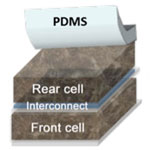 Apart from making graphene, graphene oxide itself itself is a fascinating material that has many intriguing properties. Researchers have now developed a graphene-based conductive glue that can function as a metal-free solder for creating mechanical and electrical connections in organic optoelectronic devices. As a proof-of-concept, they fabricated polymer tandem solar cells - multi-junction photovoltaic devices, in which two sub-cells are stacked to achieve higher overall solar absorption - by a direct 'gluing' process. The water-based sticky interconnect and the associated adhesive lamination process could transform the serial layer-by-layer fabrication of tandem devices into a parallel mode, in which the subcells can be independently fabricated and adjusted to balance their photocurrents for achieving high efficiency.
Apart from making graphene, graphene oxide itself itself is a fascinating material that has many intriguing properties. Researchers have now developed a graphene-based conductive glue that can function as a metal-free solder for creating mechanical and electrical connections in organic optoelectronic devices. As a proof-of-concept, they fabricated polymer tandem solar cells - multi-junction photovoltaic devices, in which two sub-cells are stacked to achieve higher overall solar absorption - by a direct 'gluing' process. The water-based sticky interconnect and the associated adhesive lamination process could transform the serial layer-by-layer fabrication of tandem devices into a parallel mode, in which the subcells can be independently fabricated and adjusted to balance their photocurrents for achieving high efficiency.
Jun 10th, 2011
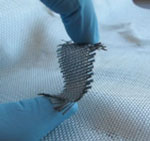 The future of your shirts, socks and gloves will be electronic. In years to come, wearable electronics will look nothing like even your smallest iPod or mobile phone today. Not only will such devices be embedded on textile substrates, but an electronics device or system could become the fabric itself. Here is some recent work that demonstrates the kind of issues scientists are working on today and that will help improve the performance of electronic textile structures. Using atomic layer deposition (ALD), researchers have grown coatings of inorganic materials on the surface of textiles like woven cotton and nonwoven polypropylene. By fabricating an all-fiber capacitor, they show that their coated materials are sufficiently conductive to perform in simple device architectures.
The future of your shirts, socks and gloves will be electronic. In years to come, wearable electronics will look nothing like even your smallest iPod or mobile phone today. Not only will such devices be embedded on textile substrates, but an electronics device or system could become the fabric itself. Here is some recent work that demonstrates the kind of issues scientists are working on today and that will help improve the performance of electronic textile structures. Using atomic layer deposition (ALD), researchers have grown coatings of inorganic materials on the surface of textiles like woven cotton and nonwoven polypropylene. By fabricating an all-fiber capacitor, they show that their coated materials are sufficiently conductive to perform in simple device architectures.
Jun 9th, 2011
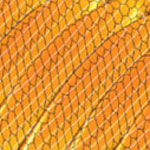 Unlike silicon, graphene lacks an electronic band gap - the gap being an energy range that cannot be occupied by electrons - and therefore has no switching capability; which is essential for electronics applications. Opening an energy gap in graphene's electron energy spectrum is therefore a critical prerequisite for instance for creating graphene transistors. That's where strain engineering of graphene comes in. Researchers have discovered that local strain in a graphene sheet can alter its conducting properties. By varying the amount of local strain, transport gaps can be tailored. In new work, researchers present a new and novel mechanism for gap opening in strained graphene via electrostatic gates and show that it can be important also in realistic situations.
Unlike silicon, graphene lacks an electronic band gap - the gap being an energy range that cannot be occupied by electrons - and therefore has no switching capability; which is essential for electronics applications. Opening an energy gap in graphene's electron energy spectrum is therefore a critical prerequisite for instance for creating graphene transistors. That's where strain engineering of graphene comes in. Researchers have discovered that local strain in a graphene sheet can alter its conducting properties. By varying the amount of local strain, transport gaps can be tailored. In new work, researchers present a new and novel mechanism for gap opening in strained graphene via electrostatic gates and show that it can be important also in realistic situations.
Jun 8th, 2011
 Water treatment is important for human consumption and environmental protection. Non-trivial purification of water involves removal of toxic ions, organic impurities, microbes and their by-products as well as scooping oil spills. The removal of organic contaminants from water is a major industrial concern. The challenging goal here is to detect, decompose and remove contaminants present usually in low concentrations. Towards this end, different types of sorbent materials have been developed to date, the most common being activated carbon. Though the use of activated carbon is still considered to be one of the best method, the disposal of adsorbed contaminants along with the adsorbent is a major concern. Researchers in India have recently come up with an innovative method for organic pollutant removal from waste water.
Water treatment is important for human consumption and environmental protection. Non-trivial purification of water involves removal of toxic ions, organic impurities, microbes and their by-products as well as scooping oil spills. The removal of organic contaminants from water is a major industrial concern. The challenging goal here is to detect, decompose and remove contaminants present usually in low concentrations. Towards this end, different types of sorbent materials have been developed to date, the most common being activated carbon. Though the use of activated carbon is still considered to be one of the best method, the disposal of adsorbed contaminants along with the adsorbent is a major concern. Researchers in India have recently come up with an innovative method for organic pollutant removal from waste water.
Jun 7th, 2011
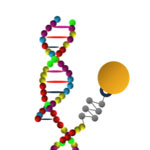 MicroRNAs (miRNAs) are short ribonucleic acid molecules, consisting of 21-25 nucleotide bases, that negatively regulate gene expression, also termed as gene silencing. Each miRNA is thought to regulate multiple genes, and since the human genome encodes hundreds of miRNAs, the potential regulatory circuitry afforded by miRNA is enormous. Recent discoveries suggest the association of specific miRNA sequences with a spectrum of diseases including cardiovascular and autoimmune diseases, as well as with a variety of cancers. It is therefore imperative, for diagnostics and prognostics, to accurately measure the expression levels of target miRNA molecules in patients' tissue samples or body fluids. To that end, researchers have developed an alternative way for the direct analysis of miRNAs in an array format, demonstrating fast and ultrasensitive detection of specific miRNAs.
MicroRNAs (miRNAs) are short ribonucleic acid molecules, consisting of 21-25 nucleotide bases, that negatively regulate gene expression, also termed as gene silencing. Each miRNA is thought to regulate multiple genes, and since the human genome encodes hundreds of miRNAs, the potential regulatory circuitry afforded by miRNA is enormous. Recent discoveries suggest the association of specific miRNA sequences with a spectrum of diseases including cardiovascular and autoimmune diseases, as well as with a variety of cancers. It is therefore imperative, for diagnostics and prognostics, to accurately measure the expression levels of target miRNA molecules in patients' tissue samples or body fluids. To that end, researchers have developed an alternative way for the direct analysis of miRNAs in an array format, demonstrating fast and ultrasensitive detection of specific miRNAs.
Jun 6th, 2011
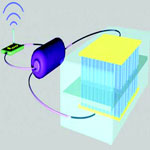 Fabrication of a single nanodevice is no longer the state of the art in nanotechnology. The leading edge - and also currently the most challenging area in nanotechnology - is research that leads to a self-powered nanoscale system that is driven by the energy harvested from its environment and that can perform its work independently and sustainable. This is a key step toward self-powered nanotechnology, which is vitally important for medical science, environmental monitoring, defence technology and even personal electronics. A research team has now provided the first demonstration that a nanogenerator can be strong enough to power a device with the capability of sensing, data processing and wireless data transmission. This is a powerful demonstration of the self-powered nanosystem and its potential applications.
Fabrication of a single nanodevice is no longer the state of the art in nanotechnology. The leading edge - and also currently the most challenging area in nanotechnology - is research that leads to a self-powered nanoscale system that is driven by the energy harvested from its environment and that can perform its work independently and sustainable. This is a key step toward self-powered nanotechnology, which is vitally important for medical science, environmental monitoring, defence technology and even personal electronics. A research team has now provided the first demonstration that a nanogenerator can be strong enough to power a device with the capability of sensing, data processing and wireless data transmission. This is a powerful demonstration of the self-powered nanosystem and its potential applications.
Jun 1st, 2011
 The small particles in volcanic ash can damage jet aircraft engines. During jet engine operation, large amounts of air are sucked in. If this air contains ash particles, especially glass-rich silicate ash, they will melt in the jet turbine's operating temperature of 1400-1500C and subsequently fuse to the turbine blades. This will drive the finely tuned blades out-of-balance and could stall the engine. In today's jet engines, a thermal barrier coating (TBC) insulates metallic engine parts from the heat generated by the combustion process. If ingested ash melts onto this coating it will penetrate it and, upon cooling, the molten ash forms a brittle glass that flakes off, taking the coating with it. A team of researchers have now examined a new class of ceramic TBC that could offer jet engines special protection against volcanic ash damage in the future.
The small particles in volcanic ash can damage jet aircraft engines. During jet engine operation, large amounts of air are sucked in. If this air contains ash particles, especially glass-rich silicate ash, they will melt in the jet turbine's operating temperature of 1400-1500C and subsequently fuse to the turbine blades. This will drive the finely tuned blades out-of-balance and could stall the engine. In today's jet engines, a thermal barrier coating (TBC) insulates metallic engine parts from the heat generated by the combustion process. If ingested ash melts onto this coating it will penetrate it and, upon cooling, the molten ash forms a brittle glass that flakes off, taking the coating with it. A team of researchers have now examined a new class of ceramic TBC that could offer jet engines special protection against volcanic ash damage in the future.
May 31st, 2011
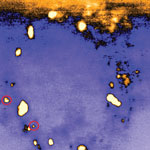 Groundbreaking research has shown a quantum atom has been tracked inside a living human cell and may lead to improvements in the testing and development of new drugs. Researchers conducted studies that confirm that non-invasive quantum measurement is possible on nanodiamonds containing a single nitrogen-vacancy (NV) spin moving within living cells. Studying the quantum properties of a single NV defect within a diamond nanocrystal, the researchers demonstrate a new technique which enables the orientation of a nanoparticle to be determined to an accuracy of less than one degree in an acquisition time of 89 milliseconds. This new technique offers biologists an extra degree of freedom when studying the translational motion of nanoparticles. Monitoring the coherence from a single electron spin paves the ways for nanoscale bio-magnetometry allowing scientists to probe changes in the cell's electromagnetic environment.
Groundbreaking research has shown a quantum atom has been tracked inside a living human cell and may lead to improvements in the testing and development of new drugs. Researchers conducted studies that confirm that non-invasive quantum measurement is possible on nanodiamonds containing a single nitrogen-vacancy (NV) spin moving within living cells. Studying the quantum properties of a single NV defect within a diamond nanocrystal, the researchers demonstrate a new technique which enables the orientation of a nanoparticle to be determined to an accuracy of less than one degree in an acquisition time of 89 milliseconds. This new technique offers biologists an extra degree of freedom when studying the translational motion of nanoparticles. Monitoring the coherence from a single electron spin paves the ways for nanoscale bio-magnetometry allowing scientists to probe changes in the cell's electromagnetic environment.
May 26th, 2011
 Apart from making graphene, graphene oxide itself itself is a fascinating material that has many intriguing properties. Researchers have now developed a graphene-based conductive glue that can function as a metal-free solder for creating mechanical and electrical connections in organic optoelectronic devices. As a proof-of-concept, they fabricated polymer tandem solar cells - multi-junction photovoltaic devices, in which two sub-cells are stacked to achieve higher overall solar absorption - by a direct 'gluing' process. The water-based sticky interconnect and the associated adhesive lamination process could transform the serial layer-by-layer fabrication of tandem devices into a parallel mode, in which the subcells can be independently fabricated and adjusted to balance their photocurrents for achieving high efficiency.
Apart from making graphene, graphene oxide itself itself is a fascinating material that has many intriguing properties. Researchers have now developed a graphene-based conductive glue that can function as a metal-free solder for creating mechanical and electrical connections in organic optoelectronic devices. As a proof-of-concept, they fabricated polymer tandem solar cells - multi-junction photovoltaic devices, in which two sub-cells are stacked to achieve higher overall solar absorption - by a direct 'gluing' process. The water-based sticky interconnect and the associated adhesive lamination process could transform the serial layer-by-layer fabrication of tandem devices into a parallel mode, in which the subcells can be independently fabricated and adjusted to balance their photocurrents for achieving high efficiency.
 Subscribe to our Nanotechnology Spotlight feed
Subscribe to our Nanotechnology Spotlight feed





